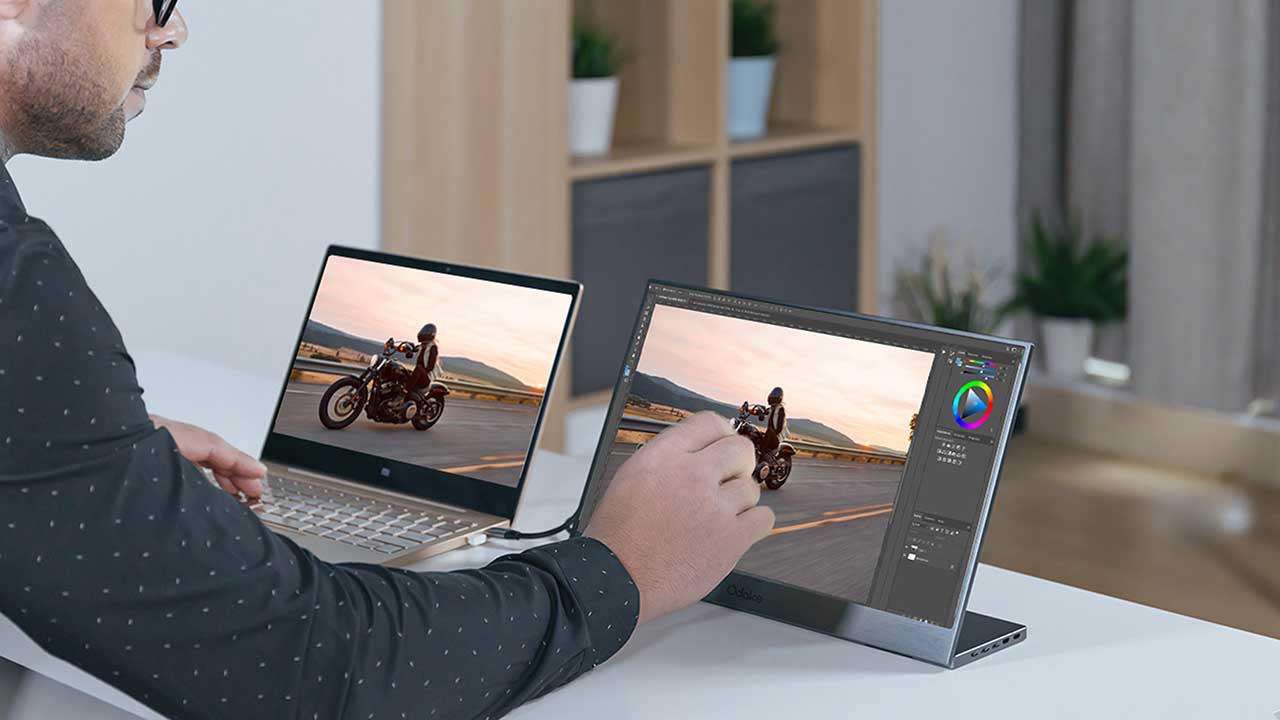Snap Verdict
Why on earth would you need a portable monitor, all laptops come with their own, so is there really a need?
After a few weeks with the Odake BladeX, I’d say the need was obvious and not just for keeping an eye on this summers tennis and cricket scores.
The overall quality is good, and with an hour and a half to two hours of charge, it gives you time to do plenty. Having that second monitor certainly enhances the workflow for both stills and video.
Battery life is limited, and the monitor is a little on the contrasty side, but overall, it definitely a worthwhile addition to the kit bag.
Info
Portable monitor / indiegogo.com/projects/bladex-the-slimmest-on-the-go-monitor / From $179 at time of review
Intro
In the studio, I’m used to the luxury of a multi-screen setup; tool pallets and email on one screen and the workspace on the other. Out in the field, however, I have my laptop, and that’s it, at least that was until the Odake Blade X monitor arrived.
Slimmer and lighter than a MacBook Pro 15-inch the Odake Blade X plugs directly into a spare display port and instantly provides you with a valuable second monitor while on the move.
What makes this compact monitor so special is the built-in battery, which means that the monitor is 100% self-supporting.
But, is this all just a luxury too far. Laptops are designed to be portable and if I already have the fantastic Linedock plugged into one port and now the BladeX in another is it all getting a little ridiculous?
Features
Before we get into the grit of the review lets take a look at the features. First and foremost, any piece of equipment that’s aiming to pile the pounds back onto my now refined and slimline field kit needs to itself be slim and lightweight.
At 4.5mm thick it certainly fits the bill for the first requirement and weight wise comes in at 0.86kg.
Connectivity comes through USB-C or HDMI for the display, and there’s a 3.5mm headphone port as well as two Micro USB-Type B ports and an additional USB Type-C.
At the base of the screen is a flip-out stand that contains the ports and enables three different angles for the monitor.
As is now standard for most monitors there are small speakers built-in, and then there’s the feature that separates this from other slimline monitors; a built-in 3000 mAh battery that provides around an hour of use at full brightness.
Sizewise the screen measures 15.6-inches and has a resolution of 1080p/4k.
Another feature that’s accessible for Windows and Android users is the touchscreen, being Mac-based we’re unable to test this feature out.
Build and Handling
There’s no doubt that the BladeX has been made to feel like a quality piece of kit. It slimline aesthetics are matched with a high-quality metal case.
The hinging of the base to the monitor all feels nice, tight and robust enough to survive life on the road.
It is a little surprising that for a product that is designed to be carried or slipped into bags for portability, a protective case hasn’t been supplied. A simple fabric one would have done to offer a bit of extra protection for the screen, but no matter.
Ports are pure and straightforward white icons dictate what each is, including the one dedicated for power in.
On the side of the base, there are three buttons, one for power and the two either side adjust the volume up or down.
These buttons feel a little cheap compared with the rest of the build quality but are perfectly adequate for what they’re designed to do.
To use the monitor, all you need to do is plug in a USB Type-C or HDMI into the base and then into your computer. This is precisely the same as any other external monitor.
Once plugged in and powered-up, it all just works, nothing else to do except arrange the monitors as you see fit.
The initial calibration of the monitor is a little screw, so I ran the SpyderX software to ensure that the BladeX and my MacBook Pro were running off the same sheet.
Performance
Using the BladeX couldn’t be easier, charge it up, plug it in and off you go. No issues there and switching between different display ports is all easy enough.
Over the month of testing, the uses for the monitor expanded, and its true potential was realised.
The small size when used in the studio when connected to the Mac with a long USB Type-C cable meant that I could keep a monitor for previewing images by my side. OK, I could do this with the laptop, but as anyone working in a busy studio will know one knock is all it takes.
The slimline nature of the monitor meant that it could sit on a small table so I could check focus and exposure without nipping back to the main computer.
There were a few issues, firstly the contrast is a little high and even when adjusted does er on the side of contrasty. Likewise, the tonal graduation isn’t as good as the MacBook Pro’s display, but this is not to do it a disservice, it’s still pretty good, especially after calibration.
The other issue is battery life; you get around an hour to two hours depending on the work that you’re doing, screen brightness, and whether you use the speakers or not.
Charging takes around two and a half hours and is through the Micro USB port on the side.
However, in most cases, a quick charge of the monitor while taking a coffee break kept things running smoothly, and a power bank, as usual, came in handy.
Otherwise, from using the monitor as a secondary display in the office to being the all-important tools monitor when video and stills editing out in the field, the Odake BladeX did a great job.
Verdict
A second monitor in any situation is always good, and once you get used to one being around, it’s a bit like that scrap of paper or notebook that always sits on the desk next to you.
The Odake BladeX fitted straight in with my workflow and enhanced it, especially away from the office.
The monitor quality was good, although the contrast was a touch high, and the tonal gradation was limited compared with the high quality of the MacBook Pro monitor, it was definitely still good enough.
The one aspect that did bug me was the battery, not so much the battery life, an hour and a half on average was good, but the fact that there was no battery level indicator did make it a little challenging to figure out how long you had left of its use.
Overall, however, the Odake BladeX is excellent and a superb addition to any portable studio setup for both stills and photography.




